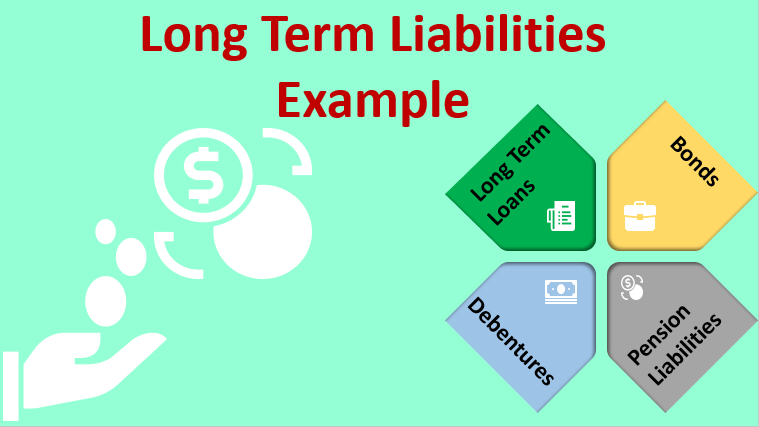Updated July 26, 2023
Definition of Long-Term Liabilities
Long-term liabilities refer to debts or obligations that are due for repayment over a period exceeding one year from the balance sheet date. These are financial obligations that a company or individual expects to settle or fulfill over an extended time frame, typically beyond the current operating cycle or fiscal year.
Examples of Long Term Liabilities
Examples of Long Term Liabilities are as follows:
#1 – Long Term Loans
A long-term loan is an example of long-term liabilities. The company holds a debt with a maturity of over 12 months. However, when a portion of the long-term loan is due within one year, that portion is moved to the current liabilities section.
Since shareholders’ funds may not fund the entire long-term portion of capital, long-term loans come into the picture. Certain capital-intensive industries like power and infrastructure require a higher component of long-term debt. However, an excessively high component of long-term loans is a red flag and may even lead to the organization’s liquidation.
Banks, financial institutions, individuals, groups, or organizations can provide long-term loans to companies. These loans serve the purpose of financing fixed assets such as plant and machinery and equipment and meeting the company’s working capital needs. The loans can be offered at a fixed rate or a variable/floating rate, with variable-rate loans tied to a benchmark rate like the London Interbank Offered Rate (LIBOR). Collateral is required as security for these loans in the case of default.
#2 – Bonds
Bonds are a part of long-term debt but with certain special characteristics. A bond is a fixed-income instrument. It represents a loan given by a borrower. Those who own the bond are the debtholders or creditors of the entity issuing the bond. Sovereign entities, municipal bodies, companies, etc., utilize bonds to raise capital. Governments generally issue bonds to fund infrastructure requirements, such as building roads, dams, airports, ports, and other projects. Companies generally issue bonds to fund their Capex requirements or research and development activities. Corporate bonds generally carry a higher interest rate than government bonds. Recognized exchanges facilitate the trading of many bonds, while others are traded over the counter (OTC), allowing for their free transferability. In certain cases, the issuer repurchases bonds before the maturity date.
The bond makes regular coupon payments throughout its duration, representing the interest payment. The bond reaches its maturity date on a specific date. Bond prices fall when there is a rise in interest rates and vice versa. Thus, bond prices and interest rates are inversely related. The initial price of a bond is generally $100 or $1,000. Companies or governments generally issue bonds at face value.
Rating agencies such as Standard and Poor, Fitch Ratings, Moody’s, etc., rate bonds based on their risk. These ratings can be Investment grade or non-investment grade. The rating represents the degree of safety of the principal and the bond’s interest. For instance, AAA-rated bonds have a very high degree of safety of principal and interest.
#3 – Debentures
In certain countries, companies issue debentures as fixed-income instruments, which can be either unsecured or secured. Debentures provide a fixed coupon rate and have a predetermined redemption date. In some countries, “debenture” is used interchangeably with “bonds.” Furthermore, certain convertible debentures can be converted into equity shares after a specific period. Non-convertible debentures, in contrast, cannot be converted into equity shares and generally carry a higher interest rate. Like bonds, debentures receive a credit rating based on risk level.
Debentures carry interest rate risk. This implies that if interest rates rise, earlier debentures may give lower interest than current debt instruments. Debentures can have either a fixed or floating interest rate. Floating rate debentures commonly use 10-year Treasury bonds as a benchmark. Investors have to take care of an issuer’s creditworthiness while investing in debentures. If investors do not consider the issuer’s creditworthiness, credit risk may materialize. In other words, the issuer may be incapable of paying due money. Another disadvantage of debentures from an investor’s perspective is that the inflation rate may be higher than the interest rate on dentures.
Before paying dividends to shareholders, companies make interest payments on debentures. Similarly, debenture payments have a higher priority than payments to shareholders in the event of the liquidation of a company. There are different categories of debentures. For instance, senior debentures have a higher priority of payment than subordinated debentures.
#4 – Pension Liabilities
Pension commitments given by an organization lead to pension liabilities. Pension liability refers to the difference between the total money due to retirees and the amount of money held by the organization to make these payments. Thus, pension liability occurs when an organization has less money than it requires to pay its future pensions. When an organization follows a defined benefit scheme, pension liabilities occur.
Conclusion
Raising long-term liabilities necessitates careful planning due to the long-term commitment involved. It requires estimating the funds needed for the long term and determining the appropriate mix of funds. Various sources, including long-term debt, bonds, debentures, etc., can be utilized to raise these funds. Each source of long-term funds has advantages and disadvantages, which should be thoroughly evaluated.
A company should take care that it keeps its long-term liabilities in check. If long-term liabilities are a high proportion of operating cash flows, it could create problems for the company. Similarly, if long-term liabilities show a rising trend, it could be a red flag.
Recommended Articles
This has been a guide to Long Term Liabilities Example. Here we discuss the introduction and example of Long Term Liabilities with a Detail Explanation. You can also go through our other suggested articles to learn more –




